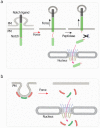A Multisensory Network Drives Nuclear Mechanoadaptation
- PMID: 35327596
- PMCID: PMC8945967
- DOI: 10.3390/biom12030404
A Multisensory Network Drives Nuclear Mechanoadaptation
Abstract
Cells have adapted to mechanical forces early in evolution and have developed multiple mechanisms ensuring sensing of, and adaptation to, the diversity of forces operating outside and within organisms. The nucleus must necessarily adapt to all types of mechanical signals, as its functions are essential for virtually all cell processes, many of which are tuned by mechanical cues. To sense forces, the nucleus is physically connected with the cytoskeleton, which senses and transmits forces generated outside and inside the cell. The nuclear LINC complex bridges the cytoskeleton and the nuclear lamina to transmit mechanical information up to the chromatin. This system creates a force-sensing macromolecular complex that, however, is not sufficient to regulate all nuclear mechanoadaptation processes. Within the nucleus, additional mechanosensitive structures, including the nuclear envelope and the nuclear pore complex, function to regulate nuclear mechanoadaptation. Similarly, extra nuclear mechanosensitive systems based on plasma membrane dynamics, mechanotransduce information to the nucleus. Thus, the nucleus has the intrinsic structural components needed to receive and interpret mechanical inputs, but also rely on extra nuclear mechano-sensors that activate nuclear regulators in response to force. Thus, a network of mechanosensitive cell structures ensures that the nucleus has a tunable response to mechanical cues.
Keywords: lipid bilayer mechano-sensing; mechano-transduction; mechanosensitive molecules; nuclear envelope; nucleus.
Conflict of interest statement
The author declares no conflict of interest.
Figures






Similar articles
-
Mechanotransduction and nuclear function.Curr Opin Cell Biol. 2016 Jun;40:98-105. doi: 10.1016/j.ceb.2016.03.006. Epub 2016 Mar 25. Curr Opin Cell Biol. 2016. PMID: 27018929 Free PMC article. Review.
-
The nucleus feels the force, LINCed in or not!Curr Opin Cell Biol. 2019 Jun;58:114-119. doi: 10.1016/j.ceb.2019.02.012. Epub 2019 Apr 16. Curr Opin Cell Biol. 2019. PMID: 31002996 Review.
-
Connecting the nucleus to the cytoskeleton by SUN-KASH bridges across the nuclear envelope.Curr Opin Cell Biol. 2013 Feb;25(1):57-62. doi: 10.1016/j.ceb.2012.10.014. Epub 2012 Nov 10. Curr Opin Cell Biol. 2013. PMID: 23149102 Free PMC article. Review.
-
The LINC Complex Assists the Nuclear Import of Mechanosensitive Transcriptional Regulators.Results Probl Cell Differ. 2022;70:315-337. doi: 10.1007/978-3-031-06573-6_11. Results Probl Cell Differ. 2022. PMID: 36348113
-
Nuclear Mechanics in the Fission Yeast.Cells. 2019 Oct 20;8(10):1285. doi: 10.3390/cells8101285. Cells. 2019. PMID: 31635174 Free PMC article. Review.
Cited by
-
Diverse Roles of the LINC Complex in Cellular Function and Disease in the Nervous System.Int J Mol Sci. 2024 Oct 26;25(21):11525. doi: 10.3390/ijms252111525. Int J Mol Sci. 2024. PMID: 39519078 Free PMC article. Review.
-
Repeat DNA methylation is modulated by adherens junction signaling.Commun Biol. 2024 Mar 7;7(1):286. doi: 10.1038/s42003-024-05990-4. Commun Biol. 2024. PMID: 38454140 Free PMC article.
-
Analysis of 2-dimensional regional differences in the peripapillary scleral fibroblast cytoskeleton of normotensive and hypertensive mouse eyes.Sci Rep. 2025 Jul 1;15(1):21207. doi: 10.1038/s41598-025-08251-4. Sci Rep. 2025. PMID: 40595239 Free PMC article.
-
The anterior gradient homologue 2 (AGR2) co-localises with the glucose-regulated protein 78 (GRP78) in cancer stem cells, and is critical for the survival and drug resistance of recurrent glioblastoma: in situ and in vitro analyses.Cancer Cell Int. 2022 Dec 8;22(1):387. doi: 10.1186/s12935-022-02814-5. Cancer Cell Int. 2022. PMID: 36482387 Free PMC article.
-
[Advances in cell nuclear mechanobiology and its regulation mechanisms].Sheng Wu Yi Xue Gong Cheng Xue Za Zhi. 2023 Aug 25;40(4):617-624. doi: 10.7507/1001-5515.202304036. Sheng Wu Yi Xue Gong Cheng Xue Za Zhi. 2023. PMID: 37666750 Free PMC article. Review. Chinese.
References
Publication types
MeSH terms
Substances
LinkOut - more resources
Full Text Sources

